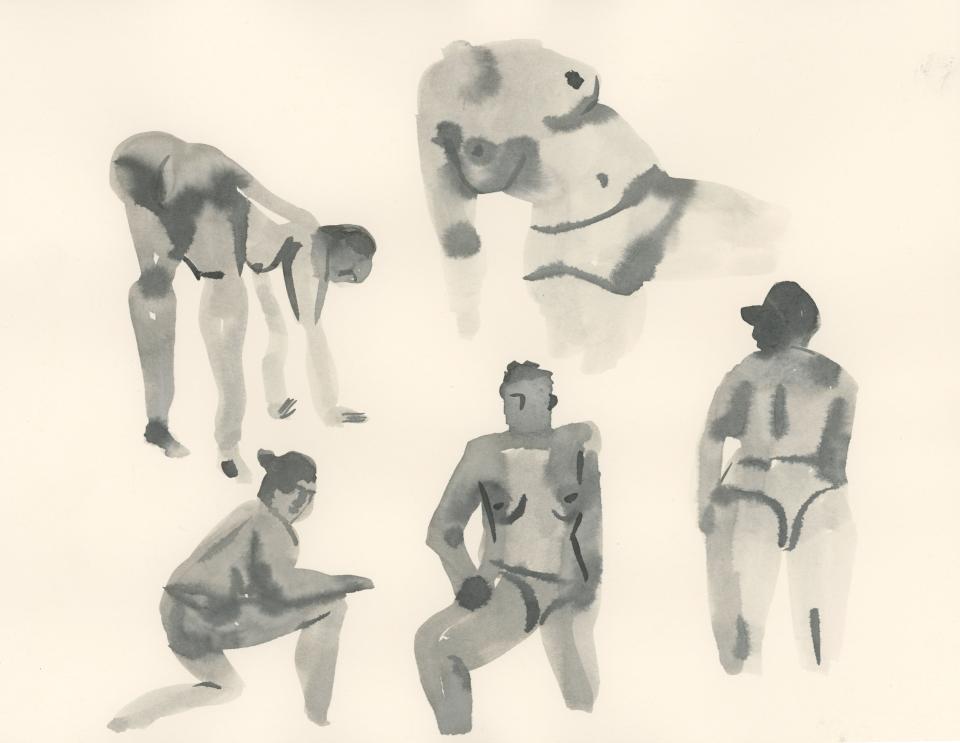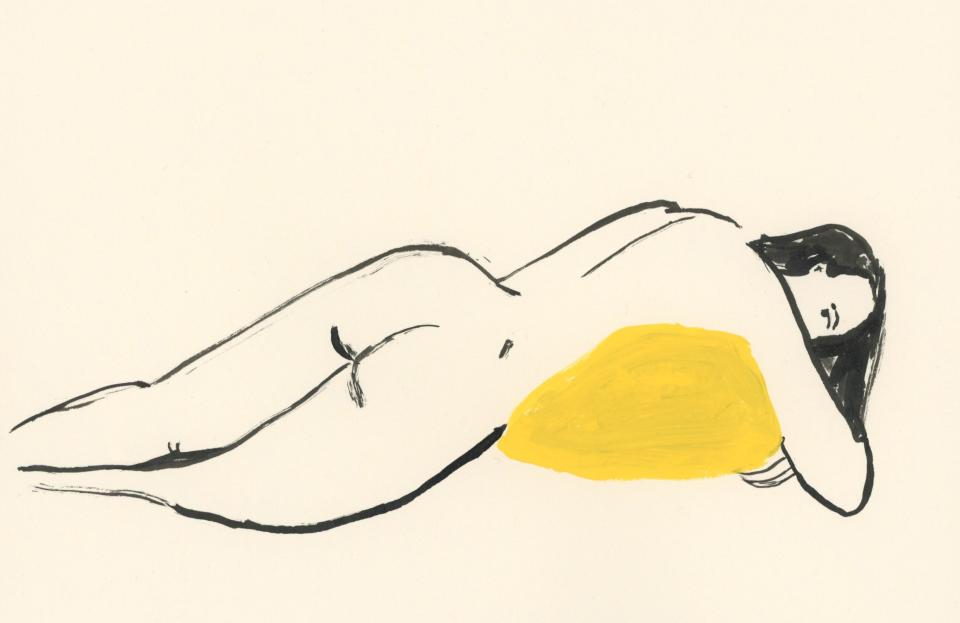Life Drawing Is So Much More Than a Hobby
In the Before Times, I had occasionally gone to life-drawing classes: part social activity, part attempt to improve drawing skills. I would say I sort of enjoyed them; I liked the atmosphere, the feeling of openness. I admired the models for their bravery and confidence, and I liked the idea of drawing with other people. But usually I got into a bit of a spiral about my drawings being no good, and about this being a mortifying disaster, as I am, allegedly, a professional artist. I felt huge self-imposed pressure to make a killer drawing every time. Of course, that’s not supposed to be the point of life drawing, but good luck telling that to my inner critic. After attending a life-drawing session, I found I didn’t want to go back for a while; I had to retreat to try to repair my artistic ego.
Now we are in a different time, and what is and isn’t enjoyable feels different. Like many artists, I had almost all my paid work evaporate when the lockdown began. I felt that I should be using this time to produce great art, or at the very least produce something. But turns out productivity is hard in a pandemic, and I found myself unable to draw, even to doodle.
After a week of hand-wringing and self-flagellation, I saw an Instagram post from artist Alex Schmidt, advertising an online life-drawing session she was running. The class was described as “an opportunity to draw and connect over embodiment.” It seemed to be offering me three things I’d been desperately missing: drawing, being connected to other human beings, and thinking about the body as something to embrace and take joy from, rather than to fear and feel trapped in.
Schmidt works under the name Body Confidence, and—alongside making her own artwork—she is a master of creating communities. She is cofounder of Dyke Soccer, a weekly pickup league for queer womxn, trans, gender-nonconforming, and nonbinary people, which has grown into a community of more than a thousand people, playing across three cities. She also runs Queer Speed Cruising, a regular event combining performance, comedy, networking, and matchmaking. And she figure-models for IRL life-drawing classes (or she did, when IRL things were able to occur).

The class had a $15 suggested donation, although Alex makes it clear on her Instagram that nobody will be turned away due to lack of funds. I signed up and gathered my materials to draw at the kitchen table. The hourlong session was conducted via Zoom (I had never used Zoom before, but I think I managed it without committing any major faux pas). Schmidt sent over some info before the class—we were all asked to keep our video on for the duration of the session, both for the feeling of community and also, vitally, to ensure there are no creeps present. And we were asked to mute our audio, so that we didn’t hear the combined sounds of dozens of people breathing and drawing and chatting to their children or friends or roommates.
There’s a playlist for each session, and it’s punctuated by the occasional person turning their audio on briefly to say “woo!” or praise a particularly amazing pose. For most of the class, we used Zoom’s speaker view, so that she took up most of the screen, clear enough to draw in detail. But I liked occasionally going back to gallery view, seeing a grid full of faces concentrating hard, glancing up from their drawing every few seconds.
The class started with moving poses: five minutes of continuous movement so that we could loosen up and not get too precious about what we were drawing. Then there was a series of one-minute poses, then two-, three-, and five-minute poses, and finally a 10-minute pose. Alex’s life modeling lives up to her nom de plume of Body Confidence; she flows through elaborate stances, sometimes using props like a kettlebell, or a lamp that she positions to create dramatic shadows. She poses holding one leg aloft, or flexing her biceps, or pinching her nipple. She plays with the frame of the computer screen, checking the angle to make sure we are getting something interesting. Sometimes she leans into that viewpoint, giving us cam-girl-esque close-ups, cropping her body in the frame.
Some poses take a few tries to get just right—for one, in which she positioned herself upside down against the corner of her sofa with legs half up the wall, she checked a few times to make sure we could see enough of her body. The first session I did with her ended with an unequivocal power pose: For the final drawing, she lay down with her head propped up against the wall, spread her legs toward the camera, and threw up a peace sign with her right hand. Somehow she held this for the entire 10 minutes. Honestly, I was awestruck.
I enjoyed the first class I took so much that I suggested a couple of friends take the next one with me; one who dialed in from lockdown in California, one in New Jersey. It felt good to look for them in the grid and see them working, to feel that I was in the same space as them, even if just a digital one. I felt enormous affection for them as I watched them drawing. Then I worried that I was being a bit voyeuristic, and I went back to my own piece. But it was nice to know they were there with me.

The sessions are part theater: Alex is there, working, playing with embodiment and ownership of one’s form, performing for us what it’s like to be comfortable in one’s body. It’s riveting. And of course, it makes for good drawing. Life drawing can sometimes feel stuffy and technical, all about accuracy and anatomy and photo-realism. It can feel like everyone is looking over everyone’s shoulder, trying to compare and see who’s doing the best. It’s a relief to be in a session with a sense of humor, that feels more about being present than about being perfect.
To be clear, a lot of the drawings I made are not very good. The poses are complex and difficult, and I can’t rely too hard on the learned formulas for bodies I get by with in my usual work. Some of the drawings go in the wrong direction right away and I throw them on the floor and start over. Some of them surprise me with how well they turn out. But mostly, I’m not thinking about if they’re good or not. There’s nobody there who can see the bad drawings I threw on the ground. I don’t have to show them to anyone, and I don’t have time to reflect on a drawing that turned out badly, because we’re already onto the next pose.
Mostly, I’m not thinking about if they’re good or not. There’s nobody there who can see the bad drawings I threw on the ground.
It is quite an amazing freedom (at least, for a self-conscious artist) to be able to draw communally like this, but without the anxiety of showing my work. I just press on, through the bad drawings, and feel buoyed up by the ones that turn out okay. I remember what it feels like to put pen to paper, to make an image, to not be focusing on the news or the stress, just thinking about the line I’m making in that moment.
I find it easier to draw on my own after these sessions. It’s woken up that part of me a bit. It doesn’t magically cure my anxiety or remove the pressure to be as productive as possible, but it does feel like a step in the right direction, and I’ll take as many of those as I can get right now.
At the end of the class, Alex asks us to show some of our drawings—if we want to. I switch into gallery mode and hold up my favorites, and see a screen full of postage-stamp-size frames of other people’s drawings too. It doesn’t matter that I’m not seeing the detail, and nobody’s judging anyone else’s work—we’re just showing that hey, we all did this, we all made something, at the same time, together. We got to be in something bigger than our apartments, and it felt good.
Originally Appeared on Vogue

